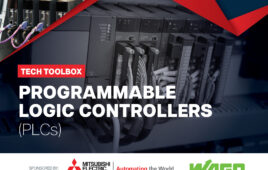
We take a look at existing controller options and introduce Commander core, a hybrid IC that provides the best of both worlds
By Jerame Chamberlain, Manufacturing Engineer Manager
The main job of any motion controller is to control the movement of a mechatronic assembly, including motors and mechanical components. Choosing the right motion controller can have lasting effects on the final product. Controllers range in complexity and capability; this article focus on whether it’s better to design your own controller from scratch, or buy off the shelf.
Designed-from-scratch units
This is the most popular option for original equipment manufacturers (OEMs), who typically build controllers in large quantities. Built from discrete components and a custom-printed circuit board (PCB), OEMs can customize their controllers with only the specific features used by their equipment, which drives the component count (and ultimately, the cost) down.
The major components fall into two categories:
- Application Specific (ASIC) devices are designed to control motors and handle the intensive calculations involved in the profile generation, multi-axis coordination and other advanced features, as well as handle the safety devices involved in their operation.
- General-purpose programmable devices (CPU, microprocessors, FPGA) are not solely for the control of motors but can be programmed to do so. They can also be used for other activities, such as operating human interface devices (HID).
The cost for these two options are very similar, but the ASIC device is a safer design choice, as the design and algorithm for motor control is time tested. Since the ASIC device algorithms are encoded fully into the semiconductor device itself and do not use a separate program, the algorithm is able to run much faster than a general purpose programmed device.
On the other hand, general purpose programmable devices are considered more flexible because they can be programmed to do much more than just profile generation. Some general-purpose devices even offer “blocks of code” for limited motion control capability, which must be adapted by the developer to add any advanced features needed. General purpose devices will run slower and are prone to interruptions from other processes, which is not an issue with ASIC devices.
Both ASIC and general-purpose devices require supporting firmware and circuit designs, which also require an experienced programmer and an electronic engineer. General-purpose devices require a programmer that is experienced in setting up and designing the device being programmed. In addition, advanced motion control requires specialized engineering experience. Even with a full engineering team, designing a from-scratch motion controller can be very slow. Utilizing an ASIC motion control device will allow you to reach market faster, as the algorithm for the motion is already fully tested and ready to go.
Since general-purpose device performance is driven by a market that is always looking for faster performance, they generally experience a much shorter life cycle than ASIC motion control devices, which typically have a longer life cycle. Either way, end-of-life for the ASIC or general-purpose device will require a complete redesign.

Ready built/off-the-shelf units
Ready-built or off-the-shelf units are systems that have already gone through the design-from-scratch process described above, and the completed package is sold as a finished unit, where the firmware and circuit designs are vetted and ready to use. These systems are usually sold as a standalone box, PLC, or PC board-level design.
Key advantages of these motion controllers include:
- Controllers are simple to program, and are often supported by industry-standard programming languages.
- They are often available with one or more standard communication interfaces.
- Standalone programs can be stored and executed without the need for a master device (such as a PC).
- Ready-built units are designed with an application or market in mind, and may incorporate standard connections, input/outputs, and axis controls that are common to the markets for which they were designed.
The downside of off-the-shelf units:
- Units will have a set number of features and are not easily adaptable. This makes it difficult to use them outside of the market for which they were designed, or to continue use as technology advances beyond the scope of the original control system.
- Full-featured packages with more flexibility are very expensive, limiting their appeal for higher volume applications. In addition, not all standard features will be necessary for every application, and therefore an OEM may be paying a premium for features they will never use.
We have seen an uptick in the number of OEM manufacturers using ready-built motion controllers to prove out a design, since they are easy to program and get up and running. However, once the equipment has been designed around a ready-built motion controller, the system must continue to use the ready-built system, even with its higher cost, or else be fully redesigned to a custom, from-scratch system.
Bridging the gap
Until now, there was no product to bridge the gap between designed-from-scratch and off-the-shelf motion controllers. Nippon Pulse is pleased to introduce its new Commander core hybrid IC, which combines all the benefits of off-the-shelf designs with the customization of design-from-scratch controllers. Commander is a brand-new tool to fill a huge need.
Commander is a very powerful and flexible motion controller, providing ease of use for engineers across a variety of market segments. Because the Commander core is a hybrid IC, it can reduce development time for the from-scratch motion controller segment. It is built around Nippon Pulse Motor Co. Ltd.’s PCL6045BL ASIC, one of the most advanced ASIC controllers on the market.
The Commander core is cost-effective for an OEM to take it to higher volume production with minimal design time and support. Once the design is proven out, the OEM can incorporate the Commander core into their final custom PCB design.
For more information about how Commander can work for you, visit nipponpulse.com/news/introducing-commander-core
Sponsored content by Nippon Pulse
Filed Under: SPONSORED CONTENT




